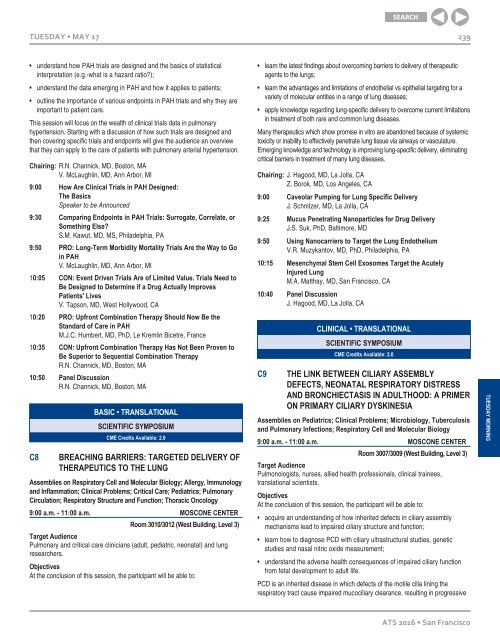Final Program
h6okmgq
h6okmgq
Create successful ePaper yourself
Turn your PDF publications into a flip-book with our unique Google optimized e-Paper software.
TUESDAY • MAY 17 239<br />
• understand how PAH trials are designed and the basics of statistical<br />
interpretation (e.g.-what is a hazard ratio?);<br />
• understand the data emerging in PAH and how it applies to patients;<br />
• outline the importance of various endpoints in PAH trials and why they are<br />
important to patient care.<br />
This session will focus on the wealth of clinical trials data in pulmonary<br />
hypertension. Starting with a discussion of how such trials are designed and<br />
then covering specific trials and endpoints will give the audience an overview<br />
that they can apply to the care of patients with pulmonary arterial hypertension.<br />
Chairing: R.N. Channick, MD, Boston, MA<br />
V. McLaughlin, MD, Ann Arbor, MI<br />
9:00 How Are Clinical Trials in PAH Designed:<br />
The Basics<br />
Speaker to be Announced<br />
9:30 Comparing Endpoints in PAH Trials: Surrogate, Correlate, or<br />
Something Else?<br />
S.M. Kawut, MD, MS, Philadelphia, PA<br />
9:50 PRO: Long-Term Morbidity Mortality Trials Are the Way to Go<br />
in PAH<br />
V. McLaughlin, MD, Ann Arbor, MI<br />
10:05 CON: Event Driven Trials Are of Limited Value. Trials Need to<br />
Be Designed to Determine if a Drug Actually Improves<br />
Patients' Lives<br />
V. Tapson, MD, West Hollywood, CA<br />
10:20 PRO: Upfront Combination Therapy Should Now Be the<br />
Standard of Care in PAH<br />
M.J.C. Humbert, MD, PhD, Le Kremlin Bicetre, France<br />
10:35 CON: Upfront Combination Therapy Has Not Been Proven to<br />
Be Superior to Sequential Combination Therapy<br />
R.N. Channick, MD, Boston, MA<br />
10:50 Panel Discussion<br />
R.N. Channick, MD, Boston, MA<br />
C8<br />
BASIC • TRANSLATIONAL<br />
SCIENTIFIC SYMPOSIUM<br />
CME Credits Available: 2.0<br />
BREACHING BARRIERS: TARGETED DELIVERY OF<br />
THERAPEUTICS TO THE LUNG<br />
Assemblies on Respiratory Cell and Molecular Biology; Allergy, Immunology<br />
and Inflammation; Clinical Problems; Critical Care; Pediatrics; Pulmonary<br />
Circulation; Respiratory Structure and Function; Thoracic Oncology<br />
9:00 a.m. - 11:00 a.m. MOSCONE CENTER<br />
Room 3010/3012 (West Building, Level 3)<br />
Target Audience<br />
Pulmonary and critical care clinicians (adult, pediatric, neonatal) and lung<br />
researchers.<br />
Objectives<br />
At the conclusion of this session, the participant will be able to:<br />
• learn the latest findings about overcoming barriers to delivery of therapeutic<br />
agents to the lungs;<br />
• learn the advantages and limitations of endothelial vs epithelial targeting for a<br />
variety of molecular entities in a range of lung diseases;<br />
• apply knowledge regarding lung-specific delivery to overcome current limitations<br />
in treatment of both rare and common lung diseases.<br />
Many therapeutics which show promise in vitro are abandoned because of systemic<br />
toxicity or inability to effectively penetrate lung tissue via airways or vasculature.<br />
Emerging knowledge and technology is improving lung-specific delivery, eliminating<br />
critical barriers in treatment of many lung diseases.<br />
Chairing: J. Hagood, MD, La Jolla, CA<br />
Z. Borok, MD, Los Angeles, CA<br />
9:00 Caveolar Pumping for Lung Specific Delivery<br />
J. Schnitzer, MD, La Jolla, CA<br />
9:25 Mucus Penetrating Nanoparticles for Drug Delivery<br />
J.S. Suk, PhD, Baltimore, MD<br />
9:50 Using Nanocarriers to Target the Lung Endothelium<br />
V.R. Muzykantov, MD, PhD, Philadelphia, PA<br />
10:15 Mesenchymal Stem Cell Exosomes Target the Acutely<br />
Injured Lung<br />
M.A. Matthay, MD, San Francisco, CA<br />
10:40 Panel Discussion<br />
J. Hagood, MD, La Jolla, CA<br />
C9<br />
CLINICAL • TRANSLATIONAL<br />
SCIENTIFIC SYMPOSIUM<br />
CME Credits Available: 2.0<br />
THE LINK BETWEEN CILIARY ASSEMBLY<br />
DEFECTS, NEONATAL RESPIRATORY DISTRESS<br />
AND BRONCHIECTASIS IN ADULTHOOD: A PRIMER<br />
ON PRIMARY CILIARY DYSKINESIA<br />
Assemblies on Pediatrics; Clinical Problems; Microbiology, Tuberculosis<br />
and Pulmonary Infections; Respiratory Cell and Molecular Biology<br />
9:00 a.m. - 11:00 a.m. MOSCONE CENTER<br />
Room 3007/3009 (West Building, Level 3)<br />
Target Audience<br />
Pulmonologists, nurses, allied health professionals, clinical trainees,<br />
translational scientists.<br />
Objectives<br />
At the conclusion of this session, the participant will be able to:<br />
• acquire an understanding of how inherited defects in ciliary assembly<br />
mechanisms lead to impaired ciliary structure and function;<br />
• learn how to diagnose PCD with ciliary ultrastructural studies, genetic<br />
studies and nasal nitric oxide measurement;<br />
• understand the adverse health consequences of impaired ciliary function<br />
from fetal development to adult life.<br />
PCD is an inherited disease in which defects of the motile cilia lining the<br />
respiratory tract cause impaired mucociliary clearance, resulting in progressive<br />
TUESDAY MORNING<br />
ATS 2016 • San Francisco


